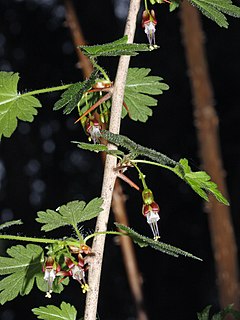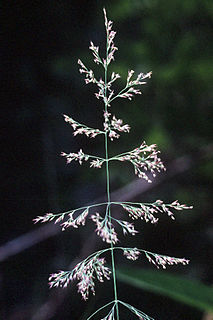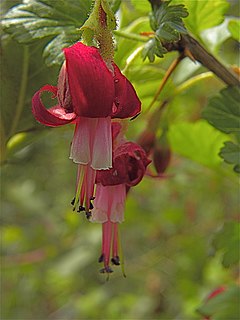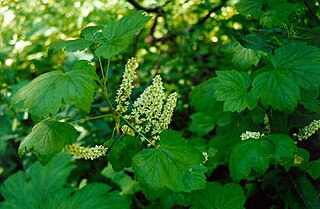
Ribes is a genus of about 200 known species of flowering plants, most of them native to the temperate regions of the Northern Hemisphere. The various species are known as currants or gooseberries, and some are cultivated for their edible fruit or as ornamental plants. Ribes is the only genus in the family Grossulariaceae.

The jostaberry is a complex-cross fruit bush in the genus Ribes, involving three original species, the blackcurrant R. nigrum, the North American coastal black gooseberry R. divaricatum, and the European gooseberry R. uva-crispa. It is similar to Ribes × culverwellii, the jochelbeere, which is descended from just two of these species, R. nigrum and R. uva-crispa.

Ribes missouriense, the Missouri gooseberry, Missouri currant or wild gooseberry, is a prickly, many-stemmed shrub native to the north-central United States. Scattered populations have been found farther east, most of them very likely escapes from cultivation.

Calamagrostis canadensis is a species of grass, having three or more varieties, in the family Poaceae. It is known variously by the common names of bluejoint, bluejoint reedgrass, marsh reedgrass, Canadian reedgrass, meadow pinegrass, and marsh pinegrass.

Ribes lobbii is a shrubby, deciduous, shade-intolerant perennial dicot found on the western coast of North America. It was first described in 1876 by Asa Gray. The specific epithet was a dedication to the English plant collector William Lobb.
Ribes amarum is a species of currant known by the common name bitter gooseberry. It is endemic to California, where it is known from mountains, foothills, and canyons. Its habitat includes Chaparral.

Ribes californicum, with the common name hillside gooseberry, is a North American species of currant. It is endemic to California, where it can be found throughout many of the California Coast, Transverse, and Peninsular Ranges in local habitat types such as chaparral and woodlands.
Ribes canthariforme is a rare North American species of currant known by the common name Moreno currant.

Ribes cereum is a species of currant known by the common names wax currant and squaw currant; the pedicellare variety is known as whisky currant. The species is native to western North America.

Ribes hudsonianum is a North American species of currant, known by the common name northern black currant.

Ribes inerme is a species of currant known by the common names whitestem gooseberry and white stemmed gooseberry. It is native to western North America from British Columbia to California and westward to the Rocky Mountains. It grows in mountain forests, woodlands, and meadows.
Ribes lasianthum is a species of currant known by the common names alpine gooseberry and woolly-flowered gooseberry. It is native to California, where it can be found in the San Gabriel Mountains and the Sierra Nevada, its distribution extending just into Nevada.

Ribes montigenum is a species of currant known by the common names mountain gooseberry, alpine prickly currant, western prickly gooseberry, and gooseberry currant. It is native to western North America from Washington south to California and east as far as the Rocky Mountains, where it grows in high mountain habitat types in subalpine and alpine climates, such as forests and talus. It is a spreading shrub growing up to 1.5 meters tall, the branching stems covered in prickles and hairs and bearing 1 to 5 sharp spines at intervals.

Ribes thacherianum, with the common name Santa Cruz gooseberry, or Santa Cruz Island gooseberry, is a rare North American species of currant found only on one island off the coast of California.

Ribes velutinum is a species of currant known by the common name desert gooseberry.
Ribes victoris is an uncommon North American species of currant known by the common name Victor's gooseberry. It is endemic to California, where it grows in the chaparral and woods of canyons in the San Francisco Bay Area and counties to the north, as far as Humboldt County.

Silene douglasii is a species of flowering plant in the family Caryophyllaceae known by the common name Douglas's catchfly.
Symphoricarpos parishii, or Parish's snowberry, is a North American species of flowering plant in the honeysuckle family. It had been found in California, Nevada, Arizona, and Baja California.

Symphyotrichum divaricatum is an annual and herbaceous plant commonly known as southern annual saltmarsh aster. It is native to the southern United States and some northern states of Mexico.















